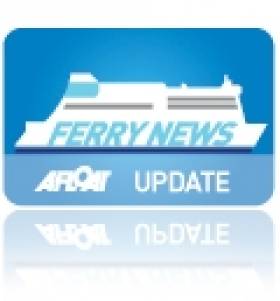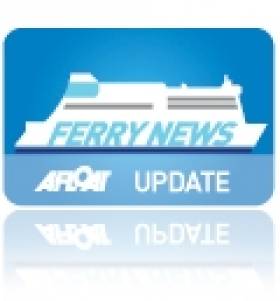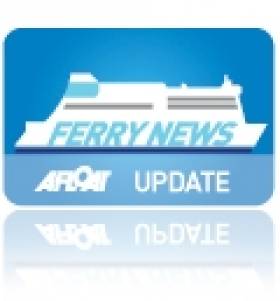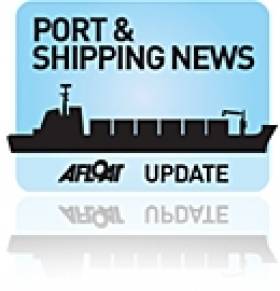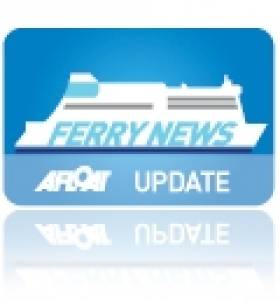Displaying items by tag: BelfastHeysham
Stena Line has announced that it is constructing two new bespoke freight ferries for Irish Sea service on its expanding Belfast-Heysham freight route.
The multi-million pound investment will significantly increase freight capacity on the route.
Each of the two new 147-meter vessels has been designed to maximise freight volumes and will provide 2,800 lane meters of capacity which is an 80% increase on current ship capacities.
The new vessels will be equipped to carry 12 passengers and 26 crew. The ‘NewMax’ vessels will be able to operate on methanol fuel.
Stena Line is currently working closely with the supply chain of methanol and has secured future volumes of e-methanol to fulfil its strategic ambition of shifting to renewable fuels and cutting 30% of its CO2 emissions by 2030.
Future proofing of the new vessels for electrification will also be another priority during construction providing in-built technologies that can take advantage of both battery propulsion and shore power, where this is available.
The unique tidal systems prevailing in Heysham can be challenging, so each vessel will be fitted with a bespoke marine technology configuration making it more resilient to the prevailing weather conditions. Three bow thrusters will provide optimum maneuverability and reliability and a specially designed engine/propeller configuration will further enhance berthing capability in extreme weather.
Paul Grant, Stena Line Trade Director said: “This is very significant day for Heysham-Belfast freight traffic. By adding an extra 80% capacity to the route, Stena Line has responded to growing demands from customers.
We have operated a very popular service on Heysham-Belfast for several years now but with restricted capacity it has been challenging to meet increased market growth. With the extra capacity, we will now be able to significantly enhance our service on this route and complement our Birkenhead, Cairnryan and Holyhead services.”
Phil Hall, Mersey Port Director at Peel Ports Group, said: “The Heysham-Belfast freight service is extremely important to the Port of Heysham. The construction of Stena Line’s two new ferries will go a long way towards meeting increased customer demand, while the additional capacity will allow for enhanced services for our port users. It’s a fantastic project to be supporting, and we look forward to delivering a bigger and better freight service for our customers from 2025 onwards.”
Stena Line is the largest ferry operator on the Irish Sea, with the biggest fleet offering the widest choice of routes including, combined passenger and freight services from Belfast to Cairnryan and Liverpool, Dublin to Holyhead, and Rosslare to Fishguard routes. As well as this dedicated freight only route from Belfast to Heysham, a total of up to 238 weekly sailing options between Ireland and Britain.
The ferry company also offers a direct service from Rosslare to Cherbourg and will be introducing an upgraded ship, Stena Vision, to this route for summer 2023, making this route the most frequent service from Ireland to France with 12 sailings per week.
Another Fine Performance
#SEATRUCK NEWBUILD - With the announcement of Seatruck Ferries new Belfast-Heysham route to open in May, the company have in the meantime introduced a newbuild this week on the Dublin-Heysham route, writes Jehan Ashmore.
Seatruck Performance brings additional capacity to the route to Lancashire and becomes the third newbuild to enter the Irish Sea where her sisters are operating Dublin-Liverpool sailings.
She has a length of 142 m, breadth of 25 m and a capacity of 151 units, which is 35 more than the earlier 'P' Class ships which have shifted elsewhere on the Seatruck network.
The final fourth vessel Seatruck Precision as previously reported is currently under construction at the FGS Flensburg yard in Germany and is expected to make her debut on the Irish Sea in June.
- Seatruck Ferries
- Seatruck Performance
- Seatruck Precision
- Irish Sea freightferry market
- Irish Sea freight haulage market
- Irish Sea roadhaulage sector
- Ports and Shipping News
- DubliLiverpool
- DublinHeysham
- BelfastHeysham
- FGS
- FGS Flensburg
- HeyshamMax newbuilds
- Pclass Seatruck newbuilds
- Port of Heysham
- New Irish Sea freightferry
Seatruck to Launch New Freight Route
#NEW FREIGHT ROUTE – A new route between Belfast-Heysham is to be launched by Irsh Sea freight-only specialist Seatruck Ferries early next month, according to The Irish Trucker.
The new service will be opened on 7 May using the sisters Arrow and Ranger which will be switched from their current duties out of Larne.
Later in the year Seatruck will deploy larger vessels on the new Belfast route and move the service from Heysham to Liverpool, operating from the Seatruck terminal on the City side of the Mersey.
In Belfast, Seatruck will operate from Albert Quay terminal - directly opposite the Titanic Quarter. For much more on this story click HERE.
Sponsorships of Ice-Sea Giants
Stena Line themselves will be looking forward to introducing their own giants when two of the largest ferries are to be introduced on the North Channel in the Autumn. The two chartered 30,000grt sisterships are Superfast VII and Superfast VIII. To see the vessel breaking through an an ice-flow, click PHOTO. The 203m long pair can take 1,200 passengers, around 660 cars or 110 freight vehicles. To read more about these 'Superfast' class vessels and the new £80 port terminal click HERE.
The company's area director Michael McGrath said: "It's quite fitting that we are teaming up with the Stena Line Belfast Giants at this time as we prepare to introduce two of the largest ferries every to sail between Northern Ireland and Scotland when we open our new route and port in Cairnryan this November. The two Superfast vessels will be another two Giants to add to our team."
Last year Stena Line made a £40m acquisition of the Belfast to Liverpool (Birkenhead) and Heysham routes and four vessels from DFDS Seaways. The deal was approved by the Irish authorities but remained subject to clearance from the UK's Competition Commission until late last month when they fully approved the acquisition.
This brings to six routes the company runs on its Irish Sea route network where over two million passengers were carried each year, more than its rival ferry operators combined.
- DFDS Seaways
- Belfast Harbour
- Stena Line
- North Channel
- Competition Commission
- BelfastHeysham
- Superfast VII
- Superfast VIII
- Belfast Lough News
- Belfast Port
- Odyssey Arena
- Belfast Giants
- BelfastCairnryan
- New ferryport
- Nottingham Panthers
- Sheffield Steelers
- Hockey Festival Weekend
- BelfastLiverpool (Birkenhead)
- Irish Sea ferry companies
- Irish icehockey
Trade, Tonnage and Turnover Up in Belfast Harbour
The principle driver in the ports performance came from the agri-food sector with a record 2m tonnes of grain and animal feed imports. The sector also recorded fertiliser imports alone leap by 32%, reflecting the major investment by the harbour in recent years in the dry-bulk cargo trade.
Roll-on roll-off (Ro-Ro) accounted for a 2% rise to 313,000 vehicles carried, partly due to the introduction of newer larger tonnage on the Belfast-Heysham route.
Belfast Harbour Chairman, Len O'Hagan, said: "Although trading conditions in the UK and Ireland remain weak, the increase in tonnages handled by Belfast Harbour suggests that business confidence is starting to return, albeit slowly.
"Belfast Harbour continues to operate in a highly competitive port sector, but I am pleased to note that the £160m which the Harbour invested in new facilities during the past decade has enabled it to emerge from the downturn with new customers and a presence in new sectors such as renewable energy.
Capital investment in the port worth almost £6m were undertaken during 2010, including the purchase of a new mobile crane, a 10,000 sq ft expansion in logistics space and preliminary works to support the proposed development of an offshore wind turbine terminal for DONG Energy (click HERE). The combined capital expenditure in these projects is in excess of £60m.
Within the ports real estate, projects at the Titanic Quarter progress at the Public Record Office, Belfast Metropolitan College and the core attraction of the 'Titanic Belfast' visitor centre.
Master planning for the 24-acre mixed-use City Quays site adjacent to the Harbour Office was secured. In addition planning permission was lodged for a 230,000 sq ft of space at Sydenham Business Park on the south-eastern fringes of the harbour.
Further upstream closer to the city-centre at the Abercorn Basin, initial work had been completed on a marina where there are more plans for the development of a 250-berth full-service leisure facility.
Next Monday the port's cruise business is to welcome a new cruiseship, the 66,000 tonnes Marina of Oceania Cruises. The 1,250-passenger /800 crew newbuild's arrival to Belfast comes in a year that marks the thirteenth anniversary since the first liner docked in the city. In 2011 over 30 such vessels are due to visit bringing some 50,000 passengers and crew.
- RORO
- Marina
- Port of Belfast
- Titanic
- Belfast Lough
- Belfast Harbour
- Titanic Quarter
- Len O'Hagan
- Belfast Harbour Commissioners
- Cruiseships
- Ports and Shipping News
- Dong Energy
- BelfastHeysham
- Belfast Lough News
- Drybulk
- Abercorn Basin
- Belfast Harbour Chairman Len O'Hagan
- Titanic Belfast
- Marina Oceania Cruises
- Offshore Wind Turbines
- Belfast Metropolitan College
- Sydenham Buinsess Park
- Belfast Harbour real estate
Irish Authorities Approve Stena / DFDS Merger
Of the two services, the Belfast-Liverpool (Birkenhead) is for passengers and freight while the and Belfast-Heysham port route is exclusively for freight-only users. To read more about the decision from the authority click here.
In February the UK's Office of Fair Trading (OFT) referred Stena AB's acquisition from DFDS A/S to the Competition Commission, conclusions on the report are not expected to be made until 25 July. To read more about the merger click here.
In the meantime the Belfast-Liverpool (Birkenhead) route continues trading under the name of Stena Line Irish Sea Ferries Ltd which is separately operated to Stena Line's other Irish Sea routes.
Sailings on the 8-hour route are run by the Italian built 27,510 tonnes ro-pax twins Lagan Seaways and Mersey Seaways which have been in service since the newbuilds were launched in 2005.
As the acquisition remains subject to regulatory clearance, passengers intending to travel on the route can continue to make bookings through the DFDS Seaways website by logging onto this link.
In addition the acquisition involved the sale of the South Korean built freight-ferries Hibernia Seaways and Scotia Seaways which operate Belfast-Heysham sailings.
Irish Sea Ferry Deal Under Review
Stena Line's acquisition of DFDS Seaways Irish Sea services in December, has now been referred to the UK's Competition Commission by the Office of Fair Trading (OFT).
The £40m ferry deal for two routes, Belfast-Birkenhead (run by two chartered ro-pax ferries) and the Belfast-Heysham freight-only service, included two 114-trailer capacity vessels.
The Competition Commission is expected to submit its findings by the end of July while the Irish Competition Authority is also still investigating the merger. To read more about this, click the BBC report here.


























